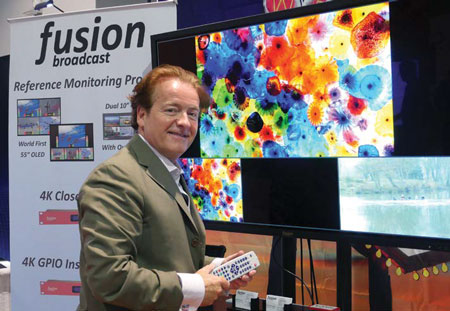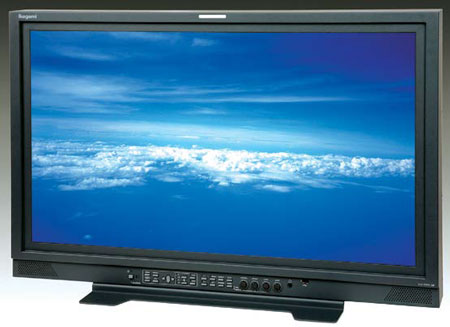Pro Monitors Get Bigger, Sharper
ALEXANDRIA, VA.—As the broadcast industry has steadily moved forward with UHD/4K production the demand for monitors that are up to the task has increased. Several companies including Canon, Dolby, Sony and Vizio have launched HDR/4K monitors and as the industry continues to move in that direction other makers could follow suit.
At the 2016 NAB Show, a number of vendors introduced the latest monitors aimed for production facilities, for use in remote operations including trucks—and one thing was clear: one size doesn’t fit all needs. The professional monitor market now has become very much like the commercial TV market where there are screens of many different sizes to accommodate a wide variety of uses and locations.
GOING BIGGER WITH OLED
Over the past several years TV screen sizes have steadily increased, and this has been driven by greater consumer adoption of 4K sets, which offer greater resolution to accommodate the larger picture. For professionals, screen size has also been on the rise.

Fusion, a startup founded by industry veterans Carl J. Dempsey (pictured), and Steve Farmer, debuted a 55-inch OLED 4K reference display at the 2016 NAB Show. Fusion, a startup founded by industry veterans Carl J. Dempsey and Steve Farmer, proved that sometimes you need to go big or go home. In making its NAB Show debut, the company rolled into Las Vegas with a 55-inch OLED 4K reference display.
The Fusion ORD-55 features independent-processing quad-mode operation (IPQ), which allows four individual processors to provide independent control of all channels while utilizing a single-link 12G input. In quad mode, the ORD-55 can handle four independent 27.5-inch FHD displays—or be configured to show one large 4K picture with three smaller preview panes.
“Clients want something that is on the large side,” said Dempsey. “Production houses want something nice and large that is of good quality to showcase their work.”
Sony also unveiled a 55-inch 4K OLED monitor at the show. The PVM-X550 is also designed for client viewing and verifying 4K footage during production. This monitor also offered a quad-view, with customized individual settings across the four distinct views in HD. This included Electro-Optical Transfer Function (EOTF), Color space, Transfer Matrix and color temperature Contrast, Bright and Chroma, Interface (3G-SDI, HD-SDI including Single Link/Dual Link and HDMI), and Signal structure (RGB and YCBCR).
The professional video industry's #1 source for news, trends and product and tech information. Sign up below.
For Sony, 4K support is very important, according to Gary Mandle, senior product manager. “Everyone on cameras today is 4K and above and we’re seeing that from other manufacturers,” he said.
Mandle also highlighted the PVM-X550’s ability to provide customized settings in the quad split.
“Having a global setting on four images doesn’t really get you much,” he added. “This separates the display into four images, but each has its own independent processing, which is managed at the monitor. This can allow for different deliverables with different comparison and other different variables. Each has its own color space, white point, gamma and frame rate setting. It provides side-by-side comparison in one pass. This is the first monitor to do that.”
The PVM-X550 joins Sony’s BVM-X300, a 30-inch OLED master monitor that was introduced last year and replaced the long-used BVMD24S CRTs. It utilizes a unique wide color gamut RGB OLED panel along with Sony’s original color management system.
Both Fusion and Sony have stated that production issues, including relatively low yield, with OLED have largely been resolved.
“We’re proudly using LG glass,” said Dempsey. “They’re putting the commitment into the glass, and we get a grade-A product from them. There isn’t a true reference standard, but what we put in our monitors is what we call ‘reference quality.’”
Mandle also highlighted the efforts that have been made to address production yields with OLED glass. “We’ve also gotten through the image burn-in issues and the blue phosphor issues,” he said. “These monitors should run for easily 30,000 hours or seven years in normal use cases.”
SMALLER SOLUTIONS
On the other end of the size spectrum JVC Professional Video and Ikegami introduced much smaller displays at the NAB Show.
JVC’s new LCD LED backlight DT-N monitors support 1080p, 720p, 1080i, 576i and 480i formats in a variety of frame rates, as well as 2K support—and include SDI, HDMI, Y/Pb/Pr, CBS and VGA video inputs, as well as SDI, HDMI and CVBS output loops. The monitors, designed for studio and field use, are available in three sizes including the 17.3-inch DT-N17F, 21.5-inch DTN21F, and 23.8-inch DT-N24F.
“Broadcasters and other professional content creators are delivering content to multiple outlets, from broadcast to the web,” said Craig Yanagi, product marketing manager at JVC Professional Video. “They are also looking for flexible ways of operation, both in the studio and the field. They need monitors they can trust to perform critical image analysis and make sure viewers are receiving the best possible image.”
All three new JVC monitors feature built-in waveform monitor, vectorscope, and histogram. Other notable features include zebra stripes, peaking focus assist, red/green/blue only display, picture freeze, and selectable gamma preset, plus three user profiles for easy image customization.

Ikegami introduced its first 4K monitor, the HQLM-3120W at the 2016 NAB Show. The DT-N17F ships with a 19-inch rack mount, which Yanagi noted makes it “ideal for rack-based production units, while the DT-N21F and DT-N24F include a VESA wall mount for use in production vehicles.”
Ikegami debuted its HLM-1751WR17 HDTV/SDTV Multi-Format LCD Color Monitor, which employs a 17-inch Full HD (1920x1080) LED backlight panel. It offers a wide critical view angle and supports multiformat SDI input, as well as 3G-SDI, DVI-D and VBS inputs. The company also introduced the HLM-1705WR17 HDTV/SDTV Multi-Format LED Backlit Monitor, designed for use in scenarios where space is limited such as sub-control rooms, editing rooms, monitor walls, transmission control desks, and outside broadcast vans.
Ikegami also introduced its first 4K monitor, the HQLM-3120W, a 10-bit LED backlit LCD panel, which features 4096x2160 resolution along with wide critical viewing angle and wide color gamut. It features 4K input via quad 3G SDI and single 12G SDI. Ikegami also offered an alternate HDR version with special high contrast panel.
“Although the 31-inch size requires close viewing to realize the benefit of 4K resolution, we have received customer requests for even smaller size 4K monitors, including rackmount size,” said Alan Keil, vice president and director of engineering at Ikegami. “As a result, we may see smaller sizes added to the product line going forward.”
The need to provide compact monitors resounded with other manufacturers, even those that went big this year. In addition to its 55-inch OLED monitor, Fusion introduced the FVM2104 series UHD dual 10-inch quadsplit monitor, which offers a full UHD resolution of 3840x2160. This side-by-side setup can display four channels of SD, HD, FHD and UHD video along with a quadsplit for all resolutions.
“Our 55-inch monitor isn’t ideal for all situations,” said Dempsey. “We introduced this product, which we think will be useful in very different areas of production.”
